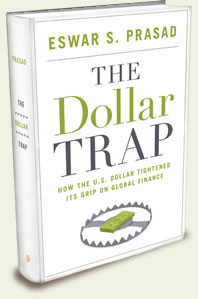The Dollar Trap
by Eswar Prasad
Is the U.S. dollar in decline? Since the global financial crisis, speculation has been rampant about its looming if not imminent displacement as the world’s leading currency. The logic seems compelling: The United States faces high and rising public debt, risks created by the Fed’s aggressive use of unconventional monetary policies, and political dysfunction. Such factors might be expected to set off an economic decline, eroding the dollar’s importance.
And yet a case can be made that the financial crisis has actually strengthened the dollar’s position as the predominant store of value in the world. True, its role as a medium of exchange may shrink over time. Financial market and technological developments are making it easier to conduct cross-border transactions in other currencies. But financial assets denominated in dollars, especially U.S. government securities, are still the preferred destination for investors interested in safeguarding their investments.
How could it be that the financial crisis, which had its epicenter in the U.S., would have the effect of tightening the dollar’s grip on global finance? By increasing the demand for safe assets even as the supply of them shrank in the rest of the world, it left America as the main provider. Emerging economies have a stronger incentive than ever to accumulate foreign exchange reserves as insulation against the consequences of volatile capital flows. Financial regulatory reforms have added to the demand, because banks need a larger supply of liquid assets to meet cash flow needs.
Prospects for U.S. currency look even better when a stark question is posed: If not the dollar, then what? The government bonds of many other major economies, such as the euro zone, Japan, and the UK, look shakier in the aftermath of the financial crisis. Moreover, even central banks, such as the Bank of Japan and the Swiss National Bank, are engaged in monetary operations that will weaken their currencies. They are also intervening directly in foreign exchange markets to prevent currency appreciation—in other words, adding to rather than serving the demand from the rest of the world for safe assets.
It may seem that this “dollar trap” is an unstable equilibrium with big risks for the global economy. One can imagine various tipping-point scenarios that might precipitate a dollar crash. But any of them would have damaging repercussions for every single country in the world. The very fear of the devastation that would be wrought by such a crash is, paradoxically, stabilizing.
All this has important implications for businesses, especially multinational corporations and financial institutions with significant cross-border operations: Managers should expect that trade and financial transactions will increasingly be intermediated in the currencies of the countries concerned rather than in the dollar. The Chinese renminbi, for instance, is rapidly ascendant as a currency for settling international payments.
With rising capital flow and currency volatility, hedging multiple currency exposures will become increasingly important. We should also expect to see the dollar’s value resume its decline against the currencies of emerging economies, owing to differences in productivity growth between the United States and those economies.
But don’t expect a decline in the dollar’s prominence. Mostly for want of a better alternative, it will remain the dominant reserve currency for a long time to come.
Eswar Prasad is the Tolani Senior Professor of Trade Policy at Cornell University, a senior fellow at the Brookings Institution, and the author of the forthcoming book The Dollar Trap (Princeton University Press, 2014).

